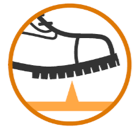Working footwear is divided into three groups:
- Protective footwear for professional use (impact resistance 200J) — compliant with EN 20345 standard
- Protective footwear (impact resistance 100J) — compliant with EN 20346 standard
- Working footwear (no impact resistance) — compliant with EN 20347 standard
The important properties of safety footwear are impact resistance, penetration resistance, slip resistance, oil resistance, heel impact attenuation, antistatic properties and water resistant treatment. Check the overview in the table at the end of this article!

One of the most important features is impact resistance due to toe protection. There are 4 different toe protection materials — steel, aluminium, plastic and composite toe caps. Since all materials have different properties we will look closer at all of these materials.
Steel toe caps — The strength and properties of steel allow for production of toe caps made of thin steel that does not affect the inner dimensions of the footwear. Steel toe caps safety properties are not affected by age or external conditions (cold/warm).
Aluminium toe caps — Thanks to the low weight of aluminium the protective footwear is about 50 g lighter than a steel toe protective footwear. Since all weight reduction comes from the front of the footwear the balance is improved, limiting strain and increasing comfort. Aluminium to protection safety properties are not affected by age or external conditions (cold/warm).
Plastic toe caps — Plastic toe protection has the strength and properties necessary for complete protection compliant with EN 20345 standard. Plastic toe protection is up to 40% lighter than steel toe protection. Access to plastic toe caps means there are completely metal-free protective footwear on the market. In addition plastic does not conduct cold nor heat.
Composite toe caps — Composite toe protection is very light and is made of plastic foam, epoxy resin and carbon fiber. Composite toe protection is characterized by being very lightweight, isolating, non-conductive and non-magnetic. Does not contain metal.

- Penetration resistant footwear are required for road construction, construction sites and roofing
- Regular sole protective footwear are required for metal manufacturing, crane operating, heating and ventilation installation, shipbuilding, transportation, lumbering e.t.c.


If you work on hot and/or cold surfaces temperature isolating footwear is required. In case of work where there exists a danger of molten material entering the footwear it is necessary to have easily removable footwear.
Overview of markings of safety footwear (compliant to EN ISO 20345 standard):
Explanation of markings presented in the table:
B – Toe protection — compliant toe caps must resist a force of up to 200J (weight of falling objects is not as important as the height of the fall which determines the collision energy). 200J is equivalent to about a 20 kg object falling from a height of 1 m.
SRA – slip protection — tested on wet ceramic surfaces.
SRB – slip protection — tested on metal surfaces.
SRC — SRA and SRB protective properties.
FO – oil protection — this means that the footwear materials do not start decaying on contact with oil.
E – energy dampening heel — this means that the heel materials will dampen impacts. They also help reduce the effect of vibration (but does not make the footwear completely vibration resistant)
P – penetration protection — to protect against sharp objects (e.g. nails e.t.c.). Standard compliant footwear must resist a force of 1 100N. For that end the materials used for the sole are metal, aluminium or kevlar which is by far the lightest and gives the footwear a soft feel. (PS! Kevlar soles isolate temperature extremely well.)
WRU – water resistant outer surface — tested to resist watering for over 60 minutes. PS! Take into consideration that water resistant footwear may not have as good breathability as footwear without water resistance.
Maintaining protective footwear
Everything used will wear out. Same applies to protective footwear. As it is with regular footwear protective footwear must be maintained:
- Store footwear dry and clean
- From time to time check the laces or velcro
- Check the soles for wear and sag
- Check the toe protection — metal toe protection will deform after damage, composite might soften and not provide as good protection during the next incident
Replace footwear if you notice any deviation from the aforementioned points! Check out the selection of protective footwear here.
CorpoWear’s work safety partner is www.risico.ee

